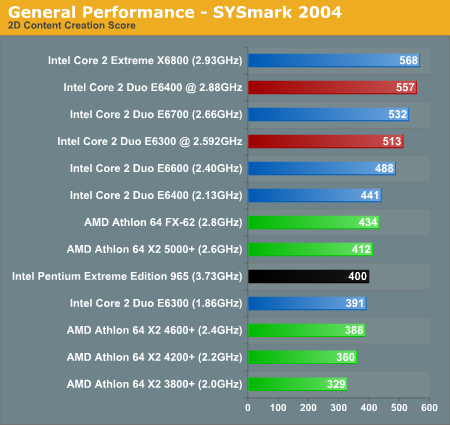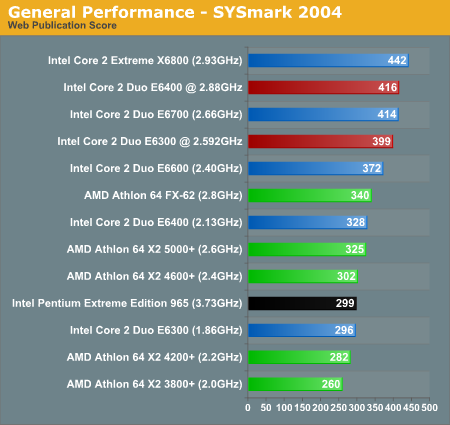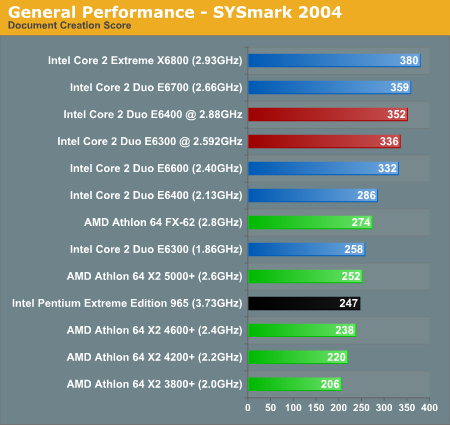Intel Core 2 Duo E6300 & E6400: Tremendous Value Through Overclocking
by Anand Lal Shimpi on July 26, 2006 8:17 AM EST- Posted in
- CPUs
Application Performance using SYSMark 2004 SE
We'll kick off our look at general application performance with SYSMark 2004 SE and as always, we'll look at the overall score as well as the scores in each of the two suites - Internet Content Creation and Office productivity.



The applications tested by SYSmark 2004 cover the vast majority of the modern computing spectrum. Everything from multimedia to office to multitasking performance is included, and while not every application will show a substantial performance increase with a faster processor, the overall performance spread among the tested CPUs is almost 75%. If you routinely do a lot of computationally intensive work on your system (surfing the web and writing email generally don't count), there's no question that you will see a substantial difference between the fastest and slowest systems we're testing.
Our first look at the E6300/E6400 with overclocking generates some interesting results. There has been speculation that one of the reasons Core 2 Duo chips perform so well is that they have so much L2 cache. Dropping from 4 MB to 2 MB of cache does hurt performance a bit, but with a little bit of overclocking both of our budget Core 2 Duo chips perform very well. The net loss appears to be about 200 MHz, so the 2.88 GHz E6400 roughly equals the 2.66 GHz E6700, and the 2.59 GHz E6300 roughly matches the 2.4 GHz E6600. Drilling down into the individual benchmark results for SYSmark 2004, the impact of the reduced cache is more apparent in Office Productivity applications than it is in the Internet Content Creation results, but the 2MB Core 2 chips preform respectably regardless of the application being tested. Perhaps a Core 2 with 1MB or less of L2 wouldn't perform all that well, but since those parts don't exist there's no reason to worry about hypothetical bottlenecks right now.
Switching over to the AMD versus Intel comparisons, the E6300 and E6400 already compete very well, and once we throw in overclocking they are basically out of reach of any of the AM2 processors -- with or without overclocking. In overall score, the overclocked E6300 is almost 20% faster than the FX-62. A 20% overclock of the FX-62 (3.33 GHz) might close the gap, but it would certainly require more than stock air cooling, and it doesn't change the fact that we are able to get extremely good performance out of Intel's $180-$220 parts.
The individual SYSMark 2004 SE scores are graphed below if you're interested; the data is used in calculating the overall scores we've already discussed above:
















137 Comments
View All Comments
goinginstyle - Wednesday, July 26, 2006 - link
Read the entire post and see what the outcome is before posting this kind of information.
Kiijibari - Wednesday, July 26, 2006 - link
That's the reason why he was using stepping 5 cores, if he would have used stepping 6, no article, no clicks, no advertising money (from Intel(?) ;-) )
I mean an overclocking article itself is nonsense, exspecially if you only have 1 kind of a specific CPU and that one is directly from Intel...
Just wait until the first guys bought E6300s because of anandtech and then stuck around ~2.0/2.2 GHz. Guess who is angry then ...
Sadly but it looks like anandtech does not care too much about that :(
regards
Kiijibari
Gary Key - Saturday, July 29, 2006 - link
The retail chips are overclocking just as well as the ES chips from all indications the past few days. I know my retail E6400 is 150MHz higher than the ES sample. ;-) Here is an example at XS.......
http://www.xtremesystems.org/forums/showthread.php...">E6700 Retail
Anand Lal Shimpi - Wednesday, July 26, 2006 - link
As soon as we can get our hands on something other than B1 stepping CPUs we'll include those results. As far as I know, there's nothing that has been changed in current silicon revisions to severely limit overclocking. I haven't run into the issues myself but I will do my best to follow up once I can get later silicon.Take care,
Anand
mkruer - Wednesday, July 26, 2006 - link
Thanks Anand,I don’t know if this is true any more but I seem to recall that Intel has a small scale FAB just for engineering samples, and I think that they tend to use it both as a test to validate the new FAB process as well as the CPU design. Thus the engineering samples tend to be better then the mass production chips. Remember the 5 GHz Prescott Intel showed off. I don’t think that anyone go a 5 GHz Prescott running from production chips without having to use liquid nitrogen to keep the chip cool.
This is something to keep in mind when benching the ES ability. The real production chip might be totally different from a thermal and OC aspect.
mine - Wednesday, July 26, 2006 - link
its been reported that there is one change in b2 retail stepping .based on 3 6800 retail versions (b2) @ (xs) b1 stepping seem to oc better than the retail versions
so right now it seems to early to prejudge ..
PetNorth - Wednesday, July 26, 2006 - link
Anand, your X2 4200+ $215 is wrong. It's EE version. Normal version is $187http://www.amd.com/us-en/Processors/ProductInforma...">http://www.amd.com/us-en/Processors/Pro...ion/0,,3...
aldamon - Wednesday, July 26, 2006 - link
Get a better mobo AT and you'll see what the E6300 can really do. The $150 Gigabyte DS3 goes well over 400 FSB with the right RAM.goinginstyle - Thursday, July 27, 2006 - link
His motherboard is fine, using stock cooling is what limited the overclocks.rjm55 - Wednesday, July 26, 2006 - link
It's been interesting to watch as AT has paid more and more attention to overclocking. Fortunately for me, the overclocking on good air cooling has been a perfect match for what I'm looking for. I just checked and the monster Tuniq cooler we saw in the Conroe launch sells for just $49. People using it say it is silent because of the huge fan that turns slow inside the core. The point is I can likely go even further with the Tuniq than Anand found here - which was impressive enough.Now that we see the headroom on even the cheapest Conroe CPUs it is hard to understnad why anyone can consider an AM2 for anything but the low-end. Until Am2 drops to 65nm the Conroe OC blows away anything I can do with my AM2 chip.
Thanks for showing us what great overclockers Conroe is turning out to be! The E6600 with 4MB cache for $312 is looking mighty sweet for me. If I remeber you got yours to 4GHz.